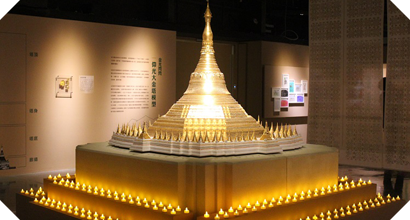
Long known as the “Land of Stupas,” Myanmar has a rich Buddhist heritage stretching back over a thousand years. Today about 90 percent of the population is Theravada Buddhist, and religion plays a role in every aspect of daily life. One of the most distinctive sights in Myanmar is the Shwedagon Stupa. Situated on top of a hill in Yangon, the nation’s largest city, this huge gilded stupa covered with gems has been a focal point of devotional offerings for many centuries.
The four themes of the exhibition are: “Life and Culture”; “Buddhist Stupas”; “Myanmar and Taiwan”; and “Religious Art.” This is the first exhibition held in Taiwan on the religion and culture of Myanmar, and features a specially made model of the Shwedagon Stupa, which gives visitors a distinct impression of Buddhist devotional architecture in Myanmar.
This section of the exhibition presents the festivals and daily lives of the people of Myanmar.
Stupas are the most distinctive feature of Burmese religious architecture. Located on the highest point in Yangon, the Shwedagon Stupa (often erroneously referred to as a pagoda, a similar structure seen throughout the Far East) is a focal point of Buddhist worship in Myanmar. This is the first scale model ever made of this world-famous stupa.
Following the Chinese Civil War, a large number of ethnic Chinese emigrated from Myanmar to Taiwan, bringing with them their distinctive customs and traditions.
In addition to religious art, the exhibition also includes folk instruments, marionettes, and lacquerwork, all of which give visitors a vivid impression of Myanmar’s rich cultural heritage.
